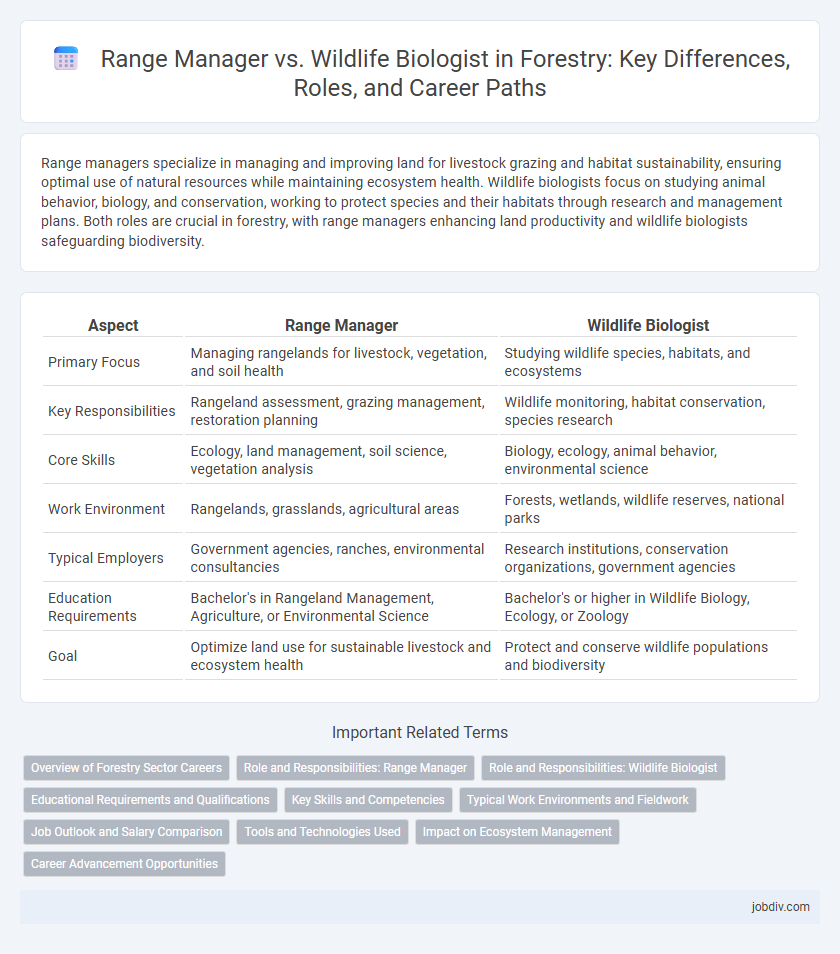Range managers specialize in managing and improving land for livestock grazing and habitat sustainability, ensuring optimal use of natural resources while maintaining ecosystem health. Wildlife biologists focus on studying animal behavior, biology, and conservation, working to protect species and their habitats through research and management plans. Both roles are crucial in forestry, with range managers enhancing land productivity and wildlife biologists safeguarding biodiversity.
Table of Comparison
| Aspect | Range Manager | Wildlife Biologist |
|---|---|---|
| Primary Focus | Managing rangelands for livestock, vegetation, and soil health | Studying wildlife species, habitats, and ecosystems |
| Key Responsibilities | Rangeland assessment, grazing management, restoration planning | Wildlife monitoring, habitat conservation, species research |
| Core Skills | Ecology, land management, soil science, vegetation analysis | Biology, ecology, animal behavior, environmental science |
| Work Environment | Rangelands, grasslands, agricultural areas | Forests, wetlands, wildlife reserves, national parks |
| Typical Employers | Government agencies, ranches, environmental consultancies | Research institutions, conservation organizations, government agencies |
| Education Requirements | Bachelor's in Rangeland Management, Agriculture, or Environmental Science | Bachelor's or higher in Wildlife Biology, Ecology, or Zoology |
| Goal | Optimize land use for sustainable livestock and ecosystem health | Protect and conserve wildlife populations and biodiversity |
Overview of Forestry Sector Careers
Range managers specialize in sustainable land use and vegetation management to support livestock and ecosystem health, blending ecology with agricultural practices. Wildlife biologists concentrate on studying animal behaviors, habitats, and conservation efforts to maintain biodiversity within forest ecosystems. Both careers contribute crucial expertise to forestry by balancing resource use with habitat preservation and environmental sustainability.
Role and Responsibilities: Range Manager
Range Managers oversee the sustainable use and conservation of rangelands by managing grazing practices, preventing soil erosion, and maintaining plant biodiversity. Their responsibilities include monitoring land conditions, implementing resource management plans, and coordinating with ranchers and landowners to balance agricultural productivity with ecological health. They utilize data on vegetation, soil, and wildlife to optimize land use while ensuring long-term sustainability of grazing ecosystems.
Role and Responsibilities: Wildlife Biologist
Wildlife Biologists conduct research on animal behavior, habitats, and population dynamics to inform conservation efforts and habitat management. They collect and analyze ecological data to assess ecosystem health and develop strategies for protecting endangered species and biodiversity. Their responsibilities include monitoring wildlife populations, advising land managers on habitat preservation, and promoting sustainable coexistence between wildlife and human activities.
Educational Requirements and Qualifications
Range Managers typically require a bachelor's degree in range science, natural resource management, or forestry, emphasizing skills in land management, livestock grazing, and habitat conservation. Wildlife Biologists generally hold a bachelor's or master's degree in biology, wildlife science, ecology, or environmental science, focusing on the study and protection of animal species and their habitats. Both professions may require field experience, but Wildlife Biologists often need advanced degrees for research or specialist roles, while Range Managers prioritize practical management skills and certifications related to land use and resource stewardship.
Key Skills and Competencies
Range Managers excel in ecosystem management, focusing on grazing systems, soil conservation, and sustainable land use practices to optimize forage production and maintain rangeland health. Wildlife Biologists specialize in species behavior, habitat assessment, and ecological research, emphasizing biodiversity conservation, population dynamics, and wildlife management strategies. Both professions require strong skills in data analysis, environmental regulations, and fieldwork, but Range Managers prioritize land resource planning while Wildlife Biologists focus on animal ecology and habitat preservation.
Typical Work Environments and Fieldwork
Range Managers typically work in open landscapes such as rangelands, grasslands, and ranches, overseeing land use for grazing and habitat sustainability, often spending extensive time outdoors conducting field assessments and managing vegetation. Wildlife Biologists operate in varied environments including forests, wetlands, and conservation areas, performing field surveys, tracking animal populations, and studying ecosystems to inform wildlife management plans. Both professions require significant fieldwork, but Range Managers focus more on land resource management while Wildlife Biologists emphasize studying and conserving animal species in their natural habitats.
Job Outlook and Salary Comparison
Range managers typically earn a median annual salary of around $65,000, with job growth projected at 5% over the next decade, driven by increasing demand for sustainable land use and livestock grazing management. Wildlife biologists have a median salary closer to $63,000, but their employment is expected to grow 8%, reflecting heightened focus on habitat conservation and biodiversity. Both careers require specialized knowledge in ecology and natural resource management, yet wildlife biology offers slightly better job outlook prospects despite comparable salary ranges.
Tools and Technologies Used
Range Managers utilize Geographic Information Systems (GIS), remote sensing, and pasture monitoring tools to analyze vegetation health, soil conditions, and grazing patterns for sustainable land management. Wildlife Biologists rely on telemetry devices, camera traps, and bioacoustic monitoring technologies to track animal movements, behavior, and habitat use within forest ecosystems. Both professions integrate data analytics software to enhance decision-making, but their specialized tools cater to managing rangelands versus studying wildlife populations.
Impact on Ecosystem Management
Range managers optimize grazing practices to sustain soil health and promote plant biodiversity, crucial for maintaining balanced ecosystems. Wildlife biologists study animal populations and their habitats to inform conservation strategies that protect species diversity and ecological stability. Both professions contribute to ecosystem management by integrating habitat preservation with resource use, ensuring long-term environmental resilience.
Career Advancement Opportunities
Range Managers often advance by specializing in rangeland restoration or becoming senior resource managers in governmental agencies, leveraging expertise in vegetation and livestock management. Wildlife Biologists tend to progress through research positions, wildlife conservation leadership roles, or academia, driven by skills in habitat assessment and species population analysis. Both careers benefit from advanced degrees and certifications, with cross-disciplinary knowledge enhancing prospects in natural resource management.
Range Manager vs Wildlife Biologist Infographic

 jobdiv.com
jobdiv.com